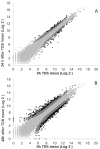Effect of Temperature Downshift on the Transcriptomic Responses of Chinese Hamster Ovary Cells Using Recombinant Human Tissue Plasminogen Activator Production Culture
- PMID: 26991106
- PMCID: PMC4798216
- DOI: 10.1371/journal.pone.0151529
Effect of Temperature Downshift on the Transcriptomic Responses of Chinese Hamster Ovary Cells Using Recombinant Human Tissue Plasminogen Activator Production Culture
Abstract
Recombinant proteins are widely used as biopharmaceuticals, but their production by mammalian cell culture is expensive. Hence, improvement of bioprocess productivity is greatly needed. A temperature downshift (TDS) from 37°C to 28-34°C is an effective strategy to expand the productive life period of cells and increase their productivity (qp). Here, TDS in Chinese hamster ovary (CHO) cell cultures, initially grown at 37°C and switched to 30°C during the exponential growth phase, resulted in a 1.6-fold increase in the qp of recombinant human tissue plasminogen activator (rh-tPA). The transcriptomic response using next-generation sequencing (NGS) was assessed to characterize the cellular behavior associated with TDS. A total of 416 (q > 0.8) and 3,472 (q > 0.9) differentially expressed transcripts, with more than a 1.6-fold change at 24 and 48 h post TDS, respectively, were observed in cultures with TDS compared to those at constant 37°C. In agreement with the extended cell survival resulting from TDS, transcripts related to cell growth arrest that controlled cell proliferation without the activation of the DNA damage response, were differentially expressed. Most upregulated genes were related to energy metabolism in mitochondria, mitochondrial biogenesis, central metabolism, and avoidance of apoptotic cell death. The gene coding for rh-tPA was not differentially expressed, but fluctuations were detected in the transcripts encoding proteins involved in the secretory machinery, particularly in glycosylation. Through NGS the dynamic processes caused by TDS were assessed in this biological system.
Conflict of interest statement
Figures




Similar articles
-
High glucose and low specific cell growth but not mild hypothermia improve specific r-protein productivity in chemostat culture of CHO cells.PLoS One. 2018 Aug 16;13(8):e0202098. doi: 10.1371/journal.pone.0202098. eCollection 2018. PLoS One. 2018. PMID: 30114204 Free PMC article.
-
Effect of shear stress on intrinsic CHO culture state and glycosylation of recombinant tissue-type plasminogen activator protein.Biotechnol Prog. 2003 Jul-Aug;19(4):1199-209. doi: 10.1021/bp025715f. Biotechnol Prog. 2003. PMID: 12892482
-
Relationship between tissue plasminogen activator production and specific growth rate in Chinese hamster ovary cells cultured in mannose at low temperature.Biotechnol Lett. 2009 Oct;31(10):1493-7. doi: 10.1007/s10529-009-0050-1. Epub 2009 Jun 23. Biotechnol Lett. 2009. PMID: 19547928
-
The emerging role of cellular post-translational modifications in modulating growth and productivity of recombinant Chinese hamster ovary cells.Biotechnol Adv. 2021 Jul-Aug;49:107757. doi: 10.1016/j.biotechadv.2021.107757. Epub 2021 Apr 22. Biotechnol Adv. 2021. PMID: 33895332 Review.
-
Enhancement of production of protein biopharmaceuticals by mammalian cell cultures: the metabolomics perspective.Curr Opin Biotechnol. 2014 Dec;30:73-9. doi: 10.1016/j.copbio.2014.06.004. Epub 2014 Jul 2. Curr Opin Biotechnol. 2014. PMID: 24995573 Review.
Cited by
-
Decoupling Growth and Protein Production in CHO Cells: A Targeted Approach.Front Bioeng Biotechnol. 2021 Jun 2;9:658325. doi: 10.3389/fbioe.2021.658325. eCollection 2021. Front Bioeng Biotechnol. 2021. PMID: 34150726 Free PMC article.
-
Comparative study of commercial media to improve GMP manufacturing of recombinant human interferon β-1a by CHO cells in perfusion bioreactor.Cytotechnology. 2022 Dec;74(6):669-680. doi: 10.1007/s10616-022-00554-y. Epub 2022 Oct 12. Cytotechnology. 2022. PMID: 36389287 Free PMC article.
-
Temperature Down-Shift Modifies Expression of UPR-/ERAD-Related Genes and Enhances Production of a Chimeric Fusion Protein in CHO Cells.Biotechnol J. 2021 Feb;16(2):e2000081. doi: 10.1002/biot.202000081. Epub 2020 Apr 27. Biotechnol J. 2021. PMID: 32271992 Free PMC article.
-
Dynamic Culture of Mesenchymal Stromal/Stem Cell Spheroids and Secretion of Paracrine Factors.Front Bioeng Biotechnol. 2022 Aug 15;10:916229. doi: 10.3389/fbioe.2022.916229. eCollection 2022. Front Bioeng Biotechnol. 2022. PMID: 36046670 Free PMC article. Review.
-
High glucose and low specific cell growth but not mild hypothermia improve specific r-protein productivity in chemostat culture of CHO cells.PLoS One. 2018 Aug 16;13(8):e0202098. doi: 10.1371/journal.pone.0202098. eCollection 2018. PLoS One. 2018. PMID: 30114204 Free PMC article.
References
-
- Fox SR, Patel UA, Yap MG, Wang DI. Maximizing interferon-gamma production by Chinese Hamster Ovary cells through temperature shift optimization: experimental and modeling. Biotechnol Bioeng. 2004; 85(2):177–184. - PubMed
-
- Yoon SK, Hong JK, Choo SH, Song JY, Park HW, Lee GM. Adaptation of Chinese hamster ovary cells to low culture temperature: cell growth and recombinant protein production. J Biotechnol. 2006; 122(4):463–72. - PubMed
Publication types
MeSH terms
Substances
LinkOut - more resources
Full Text Sources
Other Literature Sources

